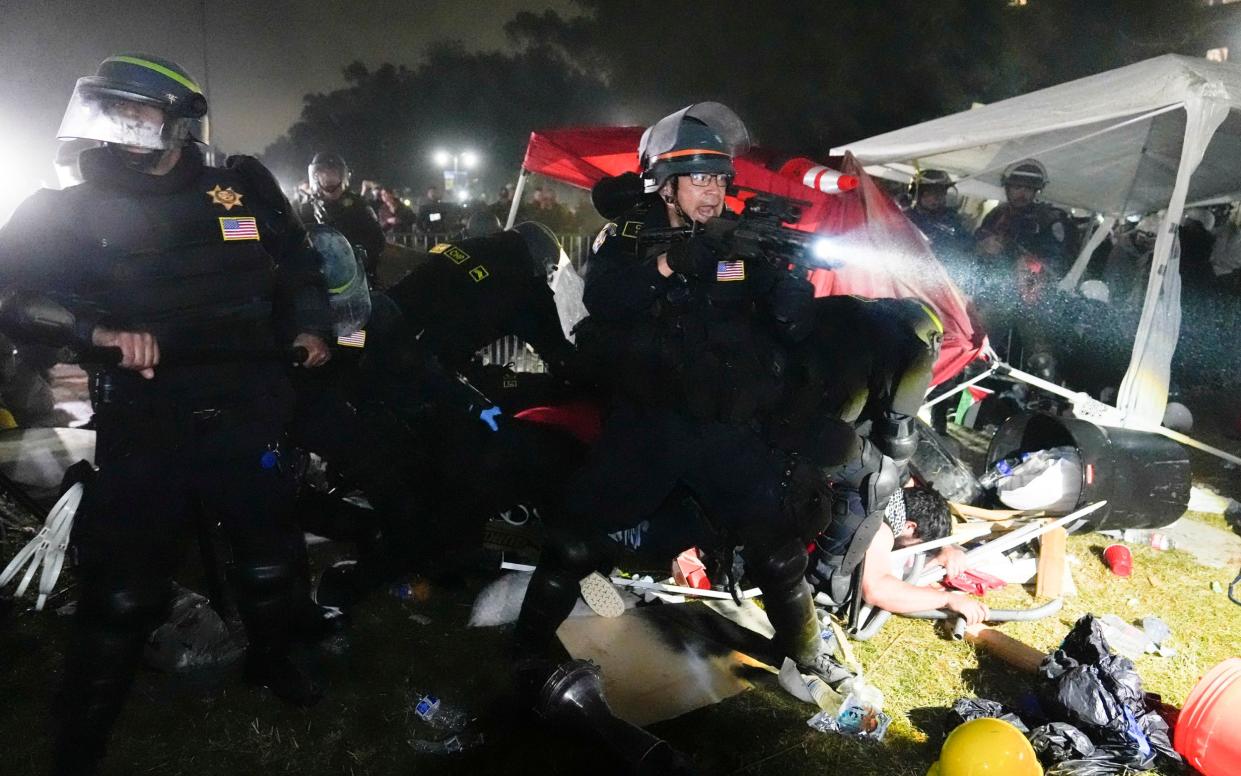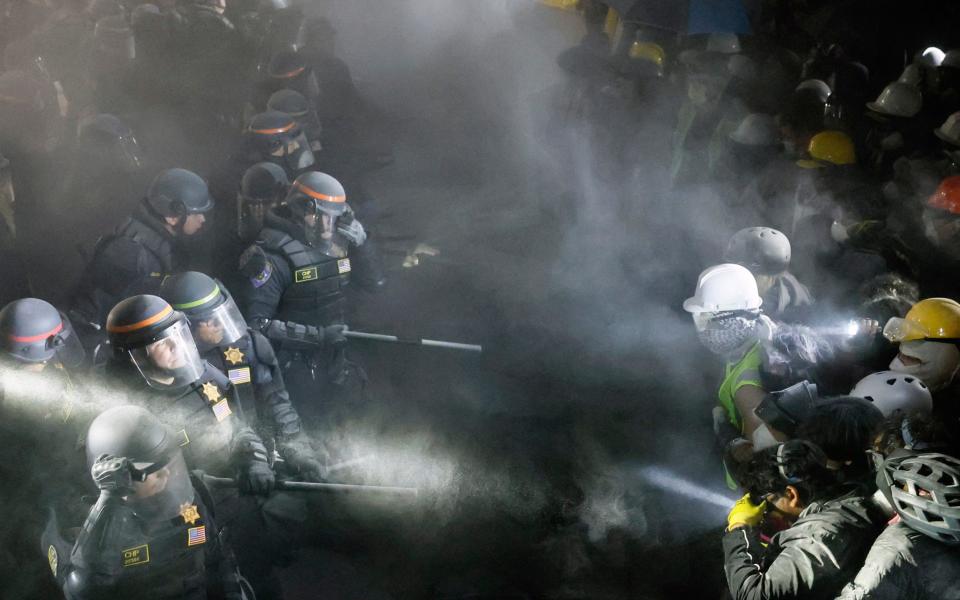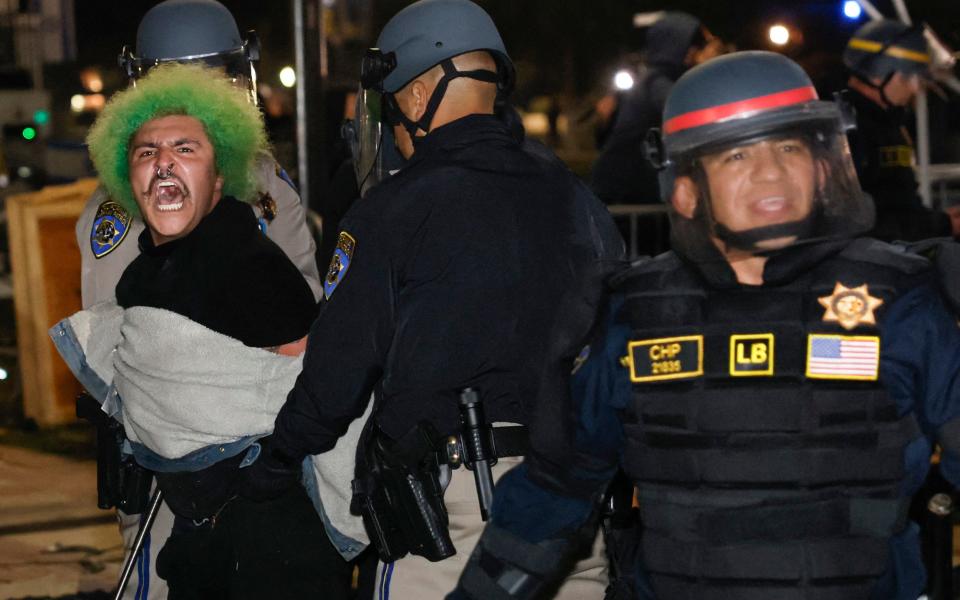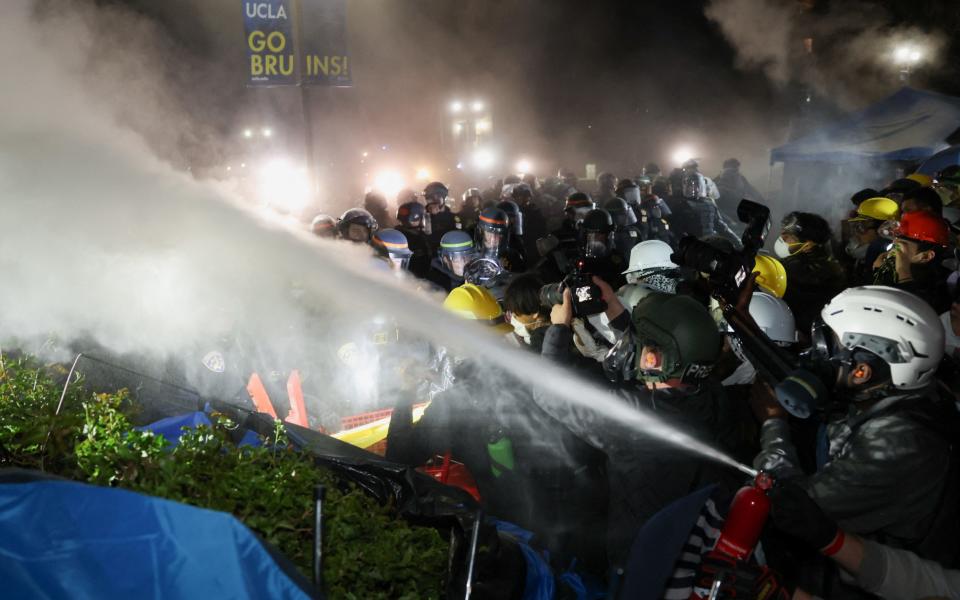‘Red brigade’ makes last stand at UCLA as police shut down campus protests across US

As they prepared for the most violent clash with police since the student protests began, demonstrators at UCLA in California separated themselves into three groups.
The green team was formed of day trippers, who planned to leave as soon as things got ugly. The yellow team would stay as long as possible, but avoid arrest, while only the hardcore reds would stay until the bitter end to defend the ramshackle pro-Palestine “encampment” on the university’s central plaza.
By dusk, the green team already had cause to go home, while the others fortified the walls around their makeshift fortress with plywood, nailed together and draped in “Free Palestine” banners.
Hundreds of police gathered in formation outside of the encampment, blaring a recorded message for the crowds to disperse. The police line was a mixture of patrol officers, specialist riot police and traffic cops, pulled in on overtime to boost the numbers.
Hearing the order to leave the area, the protesters called back: “F— you! You don’t scare us! Free Palestine!”
The encampment at UCLA became the flagbearer for the student protest movement after the original demonstration at Columbia in New York was dismantled by police on Tuesday.
Many of the demonstrators in LA said they were willing to be arrested for their cause – the divestment of their university from Israeli-linked companies in light of the war in Gaza.

A barricade of metal barriers, bins and planks of wood was formed behind the doors of Royce Hall, the 1920s architectural centrepiece of the campus where the protesters planned to hold their last stand against police.
The doors were nailed shut, and a banner hung between the building’s columns, declaring: “No genocide, end apartheid”.
The students still outside in the encampment donned helmets, goggles and respirators that paled in comparison to the riot gear worn by police. Some carried fire extinguishers raided from a nearby building, to be used in self-defence.
What began as a ring of tents in the centre of campus had become a makeshift fortress of protesters prepared for the police onslaught they had witnessed in New York the previous day.
The first salvo came shortly after nightfall, as the LAPD entered the encampment and were met with fierce resistance. As some wooden barriers were torn down, some pushed back with their hands in an attempt to keep the police line from breaching their defences.
A retreat was ordered, while the students repaired their barriers and prepared for the second wave.
At 3am, police launched a volley of flashbang grenades at what had already become known as the “front line” to scare the students away from their defences.
Lights mounted on police rifles illuminated the heads of the students – some clad in construction helmets and others in keffiyehs.
Then, at 4.06am, officers with shields and batons breached the encampment’s outer wall – tearing down the barriers and clashing with the protesters.
A police loudhailer warned that anyone remaining in the camp risked being shot with rubber bullets. Moments later, an officer fired several of the non-lethal rounds into the crowd.

Another advancing officer pointed his weapon at a cowering female protester at point-blank range.
After hours of preparation, the police invasion of the encampment was over very quickly. Officers encircled the students and advanced into the camp, dismantling tents and other constructions as they went.
Within an hour, the first arrests were made, and the last of the tents had been removed. Students fell back to the steps of Royce Hall to watch the remnants of their protest be removed. Those who refused to leave were dragged away to face charges.
Around 40 students made their last stand at the Powell Library in the north of the campus, where they linked arms as they were surrounded by riot police. They chanted: “We will rebound”.
One bearded protester, his hands bound with a zip-tie, tried to reason with police as he was taken away. “I’m a student here! I’m an English major!” he said. Then, as his thoughts turned to his grades: “Please! Don’t fail us!”
As the sun rose over LA, it was clear that the police intervention had successfully subdued the protest, but not without several well-publicised student injuries and the need for a lengthy clean-up operation. Tents, blankets, pizza boxes, a bicycle and a bunch of red roses littered the quad. One lone “Free Palestine” banner was flanked by two Israeli flags, presumably erected by a counter-protester celebrating that the encampment had been destroyed.
UCLA said classes would take place remotely on Thursday and Friday owing to an “emergency on campus”. It warned students to avoid the protest area.
In total, police said around 200 people had been arrested. The majority were charged with misdemeanour offences and released.
Americans waking up to cable news footage of the clash turned their attention to how Wednesday’s battle would be perceived on the national political stage.

Since the Columbia protest began on April 17, both university administrators and national politicians have struggled to strike a balance between the requirement to protect free speech on campus, and concern about anti-Semitism and the disruption to student learning.
That uneasy compromise has been overlaid with division over the conflict in Gaza itself, and Joe Biden’s decision to issue the United States’s “ironclad” support for Israel in its war against Hamas.
The war risks turning away many young liberals who voted for Mr Biden in 2020 and volunteered on his campaign to convince others to do the same.
In the face of opposition to his stance on Gaza, the US president has doubled down. Speaking from the White House before leaving for a campaign event on Thursday morning, the president told reporters he felt the need to address the night’s events.
“We’ve all seen the images, and they put to the test two fundamental American principles,” he said.
“The first is the right to free speech and for people to peacefully assemble and make their voices heard. The second is the rule of law. Both must be upheld.”
In his most strident comments yet on the protests, which have consumed the US news cycle for close to a fortnight, Mr Biden spoke for three minutes to condemn the actions of the protesters while defending their right to assemble peacefully.
“Vandalism, trespassing, breaking windows, shutting down campuses, forcing the cancellation of classes and graduations – none of this is a peaceful protest,” he chided the students.
“Threatening people, intimidating people, instilling fear in people is not peaceful protest. It’s against the law.”
No place for hate speech
Taking on the tone of a disappointed father, he added: “There should be no place on any campus, no place in America for anti-Semitism or threats of violence against Jewish students.
“There is no place for hate speech or violence of any kind, whether it’s anti-Semitism, Islamophobia or discrimination against Arab-Americans or Palestinian-Americans.”
His impromptu speech was echoed by Isaac Herzog, president of Israel, who said he was concerned that US universities had been “contaminated by hatred and anti-Semitism”.
Mr Herzog sent a message of support to Jewish students amid a “dramatic resurgence in anti-Semitism and following the hostilities and intimidation… on campuses across the US in particular”.
So prominent was news coverage of the UCLA protests on Thursday morning that it all but eclipsed the other story that has riveted the country for weeks: Donald Trump’s first criminal trial in New York.
Before heading to the courtroom on Thursday, Mr Trump warned of a “radical Left revolution taking place” in the US, and placed responsibility at Mr Biden’s door.
“These are radical-Left lunatics, and they have got to be stopped now because it’s going to go on and on, and it’s going to get worse and worse,” he said.
“They take over countries, and we are not letting them take over the USA. We’re not letting the radical-Left morons take over this country. You can’t let that happen.”
As Thursday wore on, it seemed the approach taken by UCLA and Columbia in clearing the demonstrators had become the blueprint for colleges across the US.
Dozens of pro-Palestine demonstrators at Portland State University in Oregon had established their own encampment, fortified with wooden pallets in the same style as the protesters at UCLA. Police surrounded them and moved in to make arrests, as Dartmouth College in New Hampshire announced it too had sent in officers to remove protesters on Wednesday night.
From the White House down, the message to the latest wave of student protesters has become clear: leave the encampments, or expect to feel the weight of the law.
Sergio Olmos is a reporter with the non-profit news organisation CalMatters

